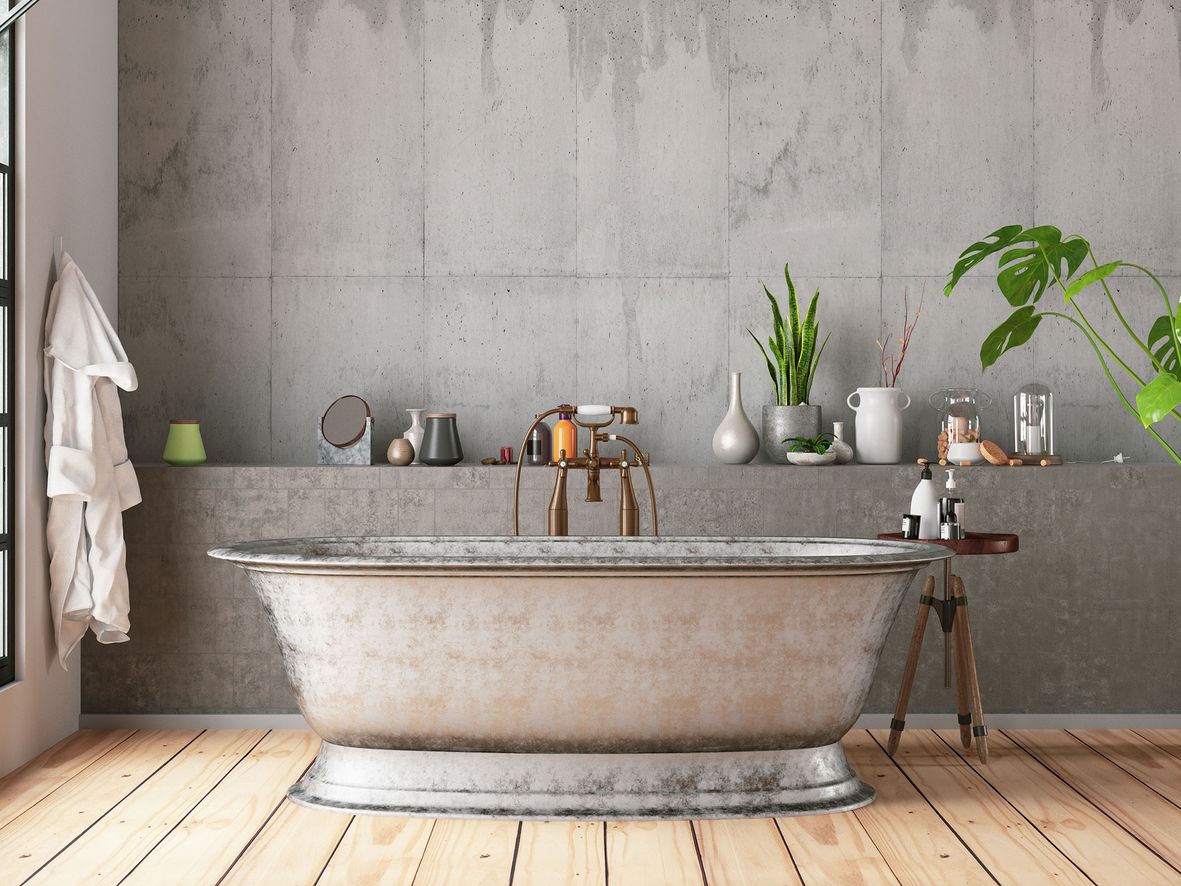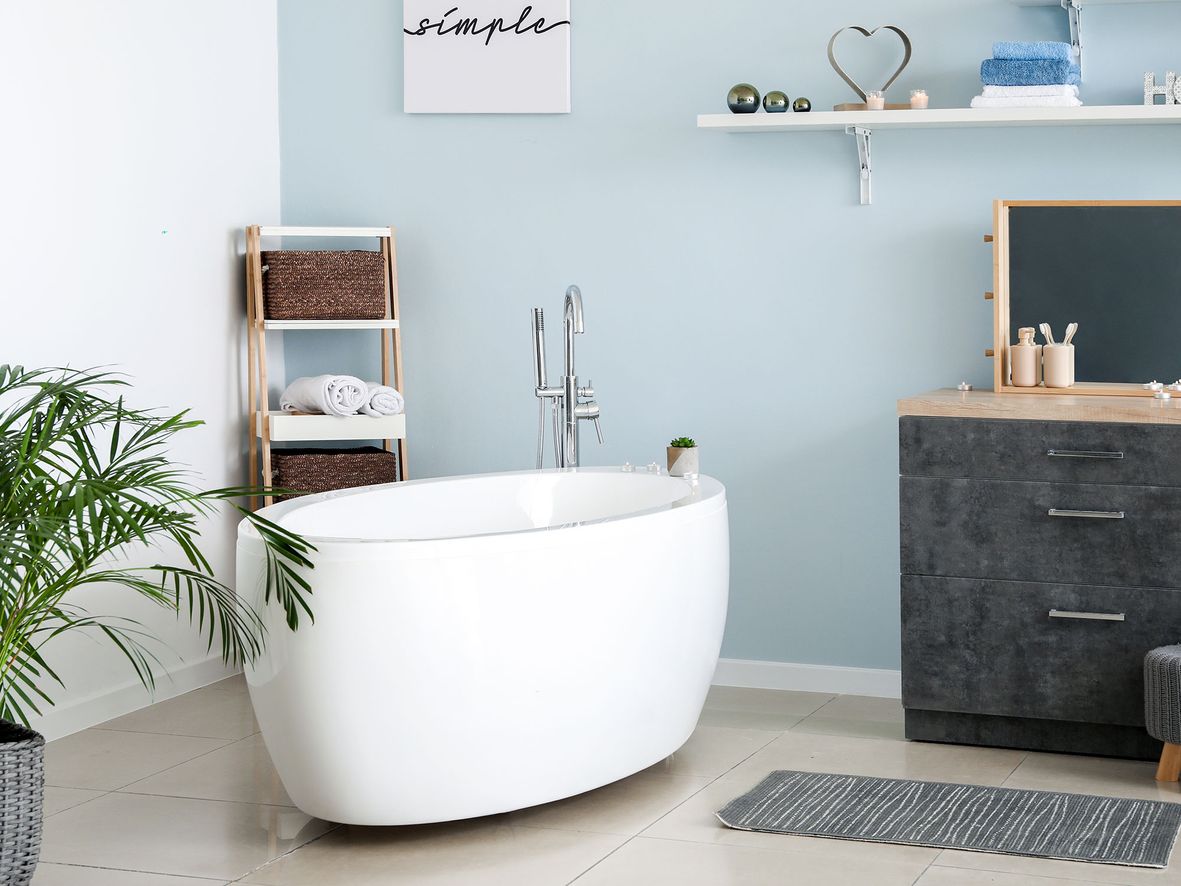By clicking a retailer link you consent to third-party cookies that track your onward journey. This enables W? to receive an affiliate commission if you make a purchase, which supports our mission to be the UK's consumer champion.
How to design a bathroom: decor ideas and tips

Your bathroom or shower room needs to be functional and practical, but good design can also turn it into a stylish haven where you can relax and unwind.
Follow these tips to strike the right balance, find out how to keep the cost of a new bathroom down and navigate the planning process smoothly.
Whether your bathroom is spacious or bijou, you'll want to get the most for your money.
Read our best bathroom brands guide to find out how big names like B&Q, Victorian Plumbing and Ikea scored for quality, durability and value for money.
Bathroom decor ideas
Bathrooms come in all shapes and sizes, as do the budgets to create them. Whether you're putting together an en suite from scratch or revamping a wet room, first and foremost think about who will use the bathroom and how, as this will affect how you design it.
We asked Tom Reynolds, CEO of the Bathroom Manufacturers Association (BMA), about the most important considerations for a consumer when planning a bathroom.
'Choosing between a bath or a shower can often be the toughest decision in bathroom design as the shower or bath is the focal point of the whole room,' he said.
'We’re seeing wet rooms becoming increasingly popular, as property owners shower more and want facilities that will suit all generations. Showering is part of our daily routines, whereas baths are increasingly seen as a luxury, associated with relaxation and indulgence.
'When designing a new bathroom, most people want to create the illusion of space. Wall-hung products with hidden pipework, additional storage and sleek design also create a minimalist, elegant look.'
Along with these suggestions from the BMA, below are some key things to think about when it comes to bathroom decor and design.
En suite bathrooms
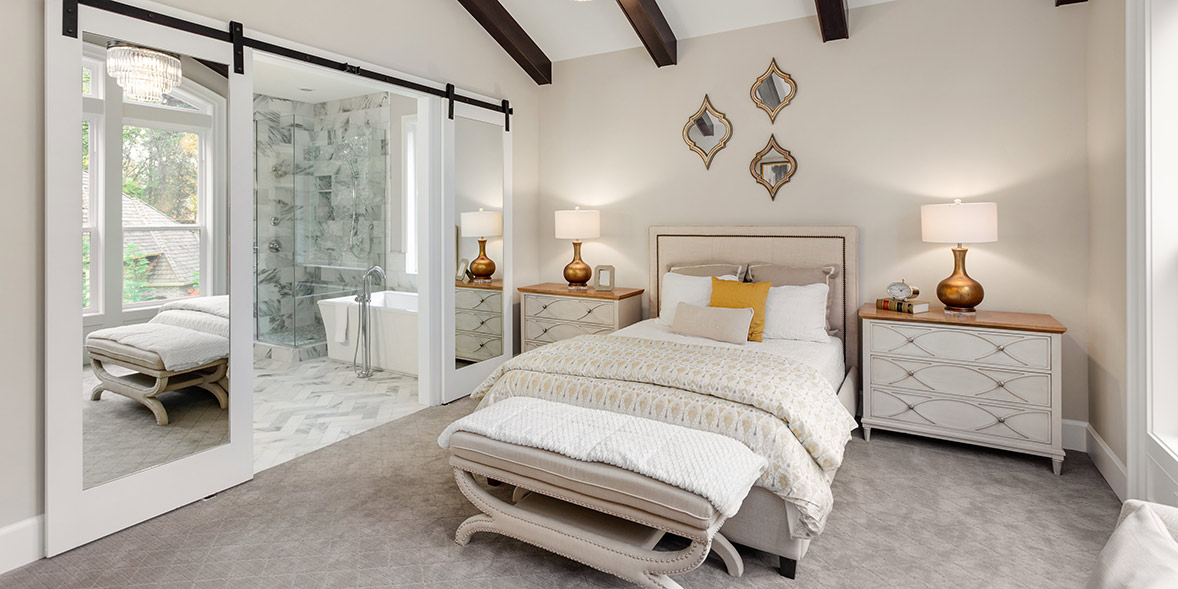
If you have an en suite bathroom, here are some ways you can make the most of a small space:
- If a bath would be too big for the room, shower enclosures come in a range of sizes. If even that will be a squeeze, a wet room might be a good option.
- Storage is particularly important in a small en suite as you'll want to make use of every inch of space. A vanity unit wrapped around a sink and toilet could make use of otherwise dead space.
- Use walls for storage, such as shelves with baskets, or rails and hooks.
- Lighting is key in a smaller and potentially darker space. Consider lights around a mirror or multiple wall or ceiling lights.
- Think about ventilation, especially given en suites open directly onto bedrooms, to avoid damp. If you have windows, open them regularly; consider adding an extractor fan or window vent.
Check out our small bathroom ideas for more tips on making the most of a compact space
Large and luxury bathrooms
- Consider getting a freestanding bath for a luxurious feel, with storage for candles and reading material close to hand.
- If you prefer to shower, opt for a super-sized shower cubicle separate to your bath. There's also a huge choice of multiple-option showers and shower heads on the market.
- Adding a double basin, if you're a couple sharing a bathroom.
- If adding a chaise lounge or seating area, make sure you think about the practicality of the fabrics/materials you opt for.
- Opt for high-end tiles – for the walls and floor – and splashbacks. Feature areas and zones with small collections of tiles, rather than covering the entire room, can keep costs down.
- Accessories are relatively inexpensive and can lift a plain or basic bathroom up to luxury standards. Touches of gold, such as a mirror, soap dish or taps, add instant luxury.
Read our bathroom furniture guide for advice on bathroom storage and to discover how our survey respondents rate big brands like Wickes and Homebase
Modern bathrooms
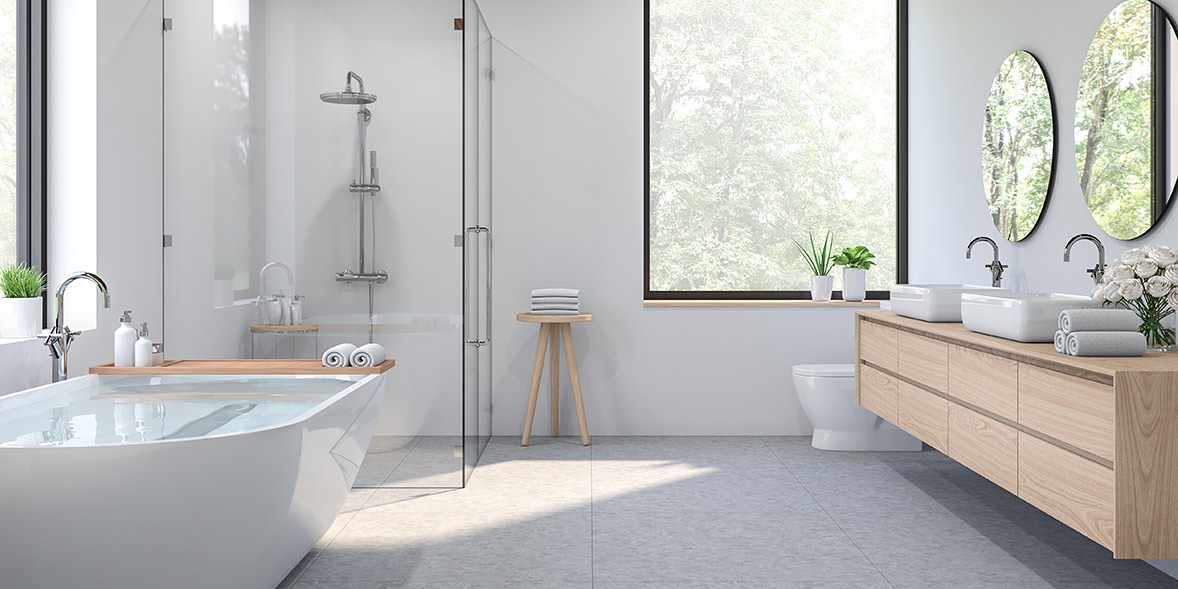
If your style is more modern, there are lots of contemporary bathroom ideas that will help you to create the look without it becoming cliched.
- White and light greys are obvious choices for a modern bathroom. But think about using different shades of both (you would be surprised at how many whites there are) to stop it seeming clinical or stereotypically modern.
- Make use of fixtures by choosing distinctive designs that will stand out. For example, opt for a radiator that almost doubles up as a piece of art.
- Adding in and mixing different materials – particularly metals, woods and concrete – will create interest and stop anything from being overpowering.
- To ensure your bathroom doesn't feel cold, use textures, such as exposed brick and rugs or bath mats.
- Modern doesn't necessarily have to mean a muted palette. Dark colours and deep shades are particularly luxurious and pops of bright colours will add impact. Be bold and paint the entire room, or choose specific areas to draw the eye, such as the wall where the bath sits.
- A bold floor pattern that is crisp and clean will give your bathroom the contemporary edge.
- Stand-out taps will add the wow factor. For example, consider a waterfall tap for your sink or different finishes for a distinctive look.
For help finding good-quality, durable products for your bathroom, read our guide to the best bathroom sinks, taps, toilets, baths and showers
Traditional bathrooms
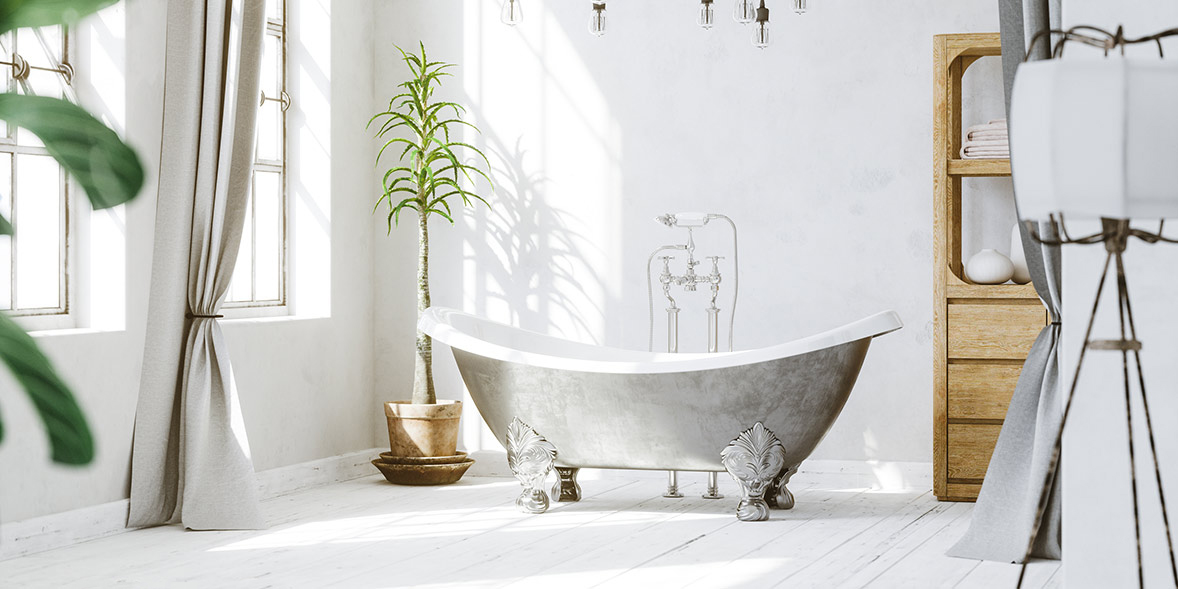
If a classic look is more your thing, there are some simple and more extensive things you can do to bring a traditional style to your bathroom.
- Wood panelling can create a traditional look instantly: more on this below.
- Opt for flooring that harks back to bygone eras, such as patterned or black and white tiles.
- Classic colours, such as sage green, rich purple and deep grey, can create a traditional feel.
- Find decorative fixtures and fittings, such as cross-head taps, metalwork toilet roll holders, a roll-top bath and a high-level toilet where the cistern sits up above the toilet.
- Bathroom suites with exposed pipework are reminiscent of the Victorian era and will add instant old-style glamour to your bathroom.
- Add touches of silver, brass or gold to create a sumptuous feel.
- Shaker furniture will make your bathroom feel classic, or, even better, upcycle antique cabinets for an authentic look.
- Add moldings around your bathroom ceiling, door and window frames and around a chandelier if that's an option.
- Consider shutters or patterned blinds, and even sash windows, if you can.
For more ideas on planning, bathroom costs and more, read our guide to bathroom suites
Family bathrooms
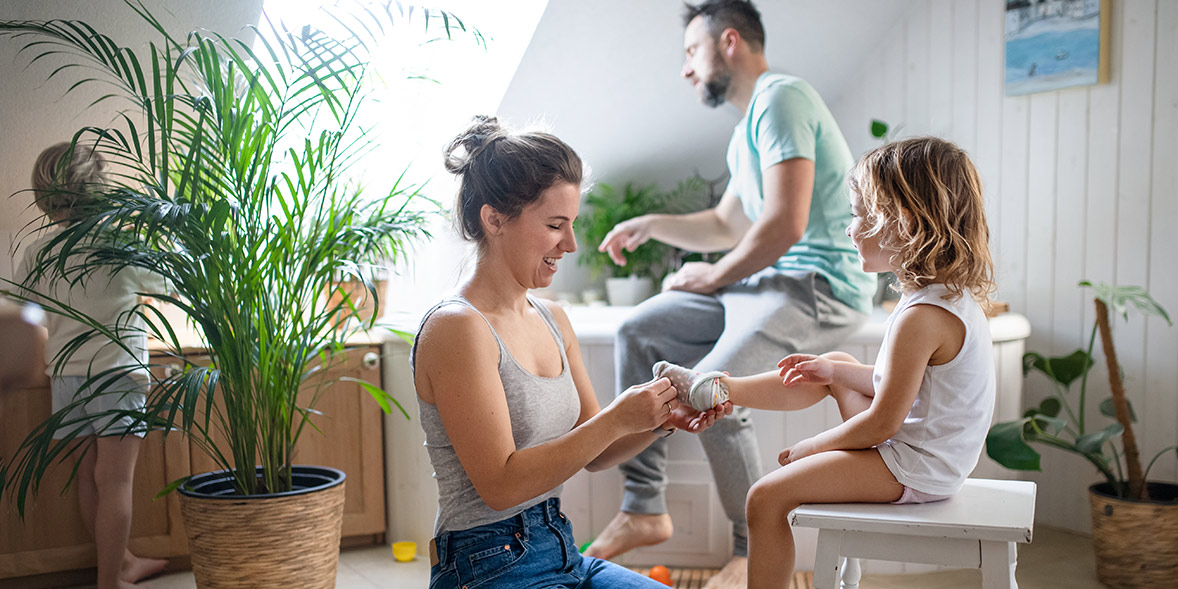
If you’re planning on renovating your family bathroom there are multiple things you'll need to factor in:
Storage and layout
- How do you want to use your bathroom? Think about what tasks you'll have to do, such as drying or changing your child. This will help determine the layout.
- Lots of storage space is essential to keep a bathroom tidy and organised. What will you need to store? Toys, kids' toiletries, changing mats? How often will you need each item and therefore where will it need to be stored for easy access?
- If children might need steps up to the sink, bath or toilet, think about what space you have for these when in and out of use. The same goes for potty and toilet-training equipment.
Cleaning
- There's no getting round it – children make a mess. Going for options that are simple to clean will make your life easier. Steer away from an all-white bathroom and include patterns and deeper colours.
- If you're painting your bathroom, choose paint that's easy to wipe clean as well as being generally bathroom-friendly. The same goes for tiles; textures, for example, can make cleaning trickier.
Safety
- Think about safety – choose non-slip flooring and/or use mats, consider curvy designs instead of harsh corners and make sure there is room for you to move around safely
- If you have a blind, make sure it's a child-friendly one, as pull cords can be dangerous for small children
- Electrical shaver power points should be out of reach of young children
- A pull-cord light is advisable so that light switches don't get touched by wet fingers. Think about the length of this – will you want your child to be able to turn the light on and off themselves when they're old enough to use the bathroom on their own?
- Think about the positioning of other items, such as mirrors, to ensure children can reach what they need to and can't access anything shouldn't be able to.
Don't forget the loo roll. Which? members can discover the best toilet rolls from our tests
Bathroom flooring and tiles
Choosing the right flooring and/or tiles for your bathroom can be one of the most important things to consider when planning a bathroom.
Bathroom flooring ideas
You can use pretty much anything for your bathroom floor as long as it’s waterproof and won’t get too slippery when wet.
Many people choose tiles (marble, stone or granite are good options), sheeted or tiled vinyl (a sensible option if you’re on a budget), or wood-effect laminate.
For an ultra-modern and very practical effect, you could even use concrete.
It’s also possible to have a hardwood floor, but you’ll need to treat it and make sure you don’t leave it wet. Another popular alternative is wood-effect porcelain tiles.
Underfloor heating adds a really cosy touch – as well as helping to dry the bathroom, and prevent damp and mould from forming – if you have hard floors.
Read our guide to electric vs water underfloor heating to find out more about installation and efficiency, plus reviews from real owners
Bathroom tile ideas
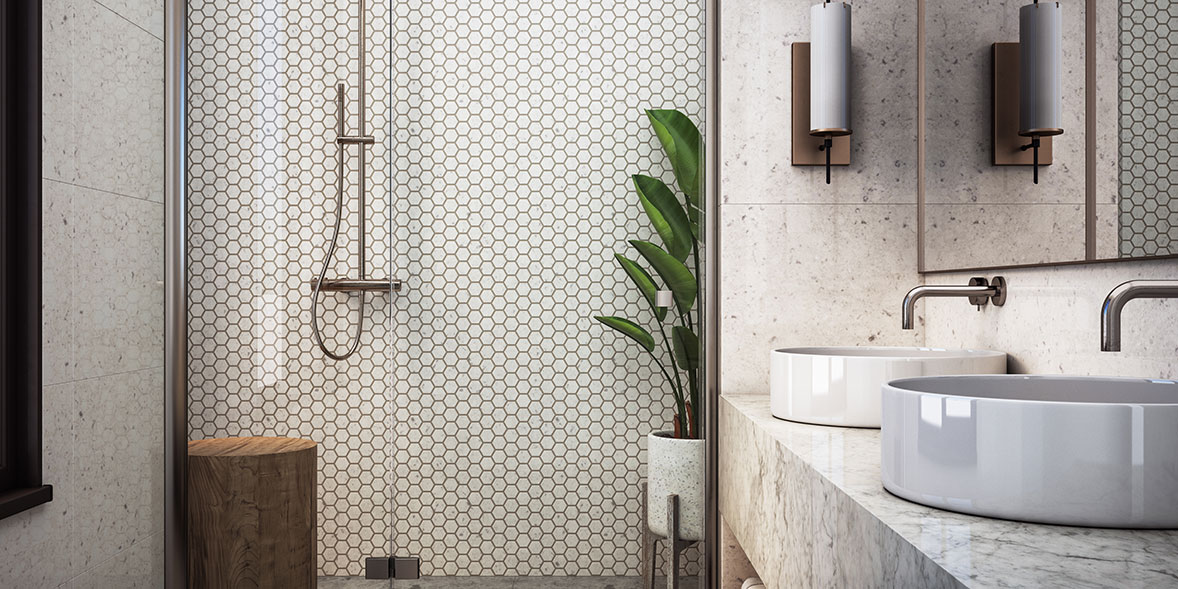
Tiles on the walls around the shower or bath should be added after these fixtures are fitted. You can get the same tiles for your bathroom walls and floor if you want a streamlined look.
Options for wall-tile types include glass, ceramic or natural stone. There are matt or gloss tiles in all shapes and sizes; mosaic tiles can add a bit of glitz to small areas, while large tiles can make a space-limited bathroom feel larger.
Natural stone tiles are very expensive to install (on walls or floors) and can be difficult to look after. Porcelain tiles that imitate stone are less expensive.
Tiles can also be used to make a statement. Bold colours, different finishes and interesting shapes can have a big impact.
You don't have to splash out on the whole room if statement tiles are pricey. Consider using them just around a shower, or in a strip running through cheaper plain white tiles, to keep costs down.
Tiling your bathroom, rather than leaving large areas painted, can make it easier to clean. Plus, tiles are less likely to develop mould or damp. Make sure you use an anti-damp tile grout.
If you're looking for your own installer to create the bathroom of your dreams, visit Which? Trusted Traders to find a recommended trader in your area. All of our endorsed traders have been put through rigorous checks to ensure they provide excellent customer service and good-quality work.
Bathroom wall panels and cladding

Bathroom wall panels or cladding can add a traditional feel to your bathroom. That is if you go for raised wooden mouldings, like in the image above.
But wall panels aren't limited to this style. You can have flat wall panels of almost anything: metal, stone, concrete or all types of wood.
They're a great alternative to tiles, wallpaper or paint and can add the wow-factor to your bathroom in a unique way. You can use them in a dedicated area, around the room on the lower part or across all walls, floor-to-ceiling.
Because of their size, they can also be cheaper than tiles – depending on the look you go for – as you'll need fewer, and make a small room look larger. You also won't have issues with grout discolouring.
Make sure you choose ones that are waterproof having been treated to withstand the conditions in your bathroom, and check where they'll be suitable – not all will be OK around your shower or sink, for example.
If you do favour traditional wood panelling but would like to update it, painting it in a up-to-date colour, matching it with contemporary furniture and suites and accessorising in the right way will bring them into the 21st century.
Bathroom wallpaper
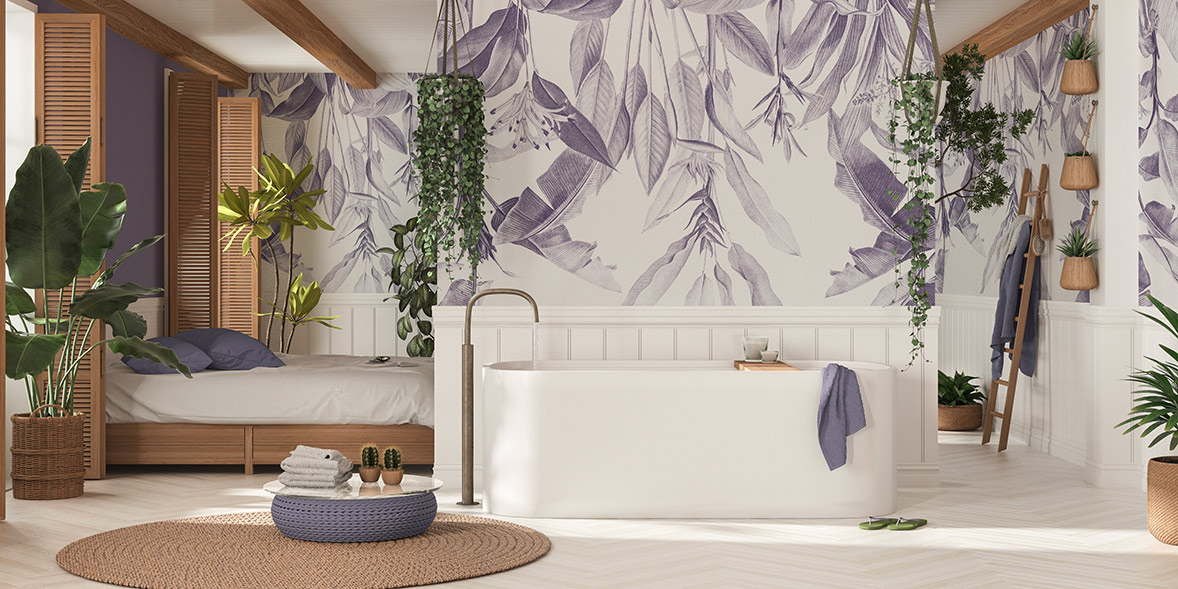
Wallpaper in a bathroom might seem like a strange idea, but there is a huge range of bathroom wallpapers that will take your bathroom from standard to stunning.
In addition, wallpaper is a great way to cover up uneven surfaces or unsightly marks that paint would simply highlight. It's also often cheaper than tiles.
But you need to get the right wallpaper, one that will withstand the moisture in your bathroom. Don't even contemplate using a general wallpaper: it needs to be a bathroom-specific one, ideally with a thick vinyl coating. This will stop it from absorbing moisture and make it wipeable.
However, as good as bathroom wallpaper can be, don't use it anywhere it will get splashed regularly, such as around a sink or shower.
Instead, use it on a feature wall or on the upper part of the wall around the room. Again, if you're feeling brave, there is no reason why you can't go bold with the design you choose. Just remember it's a small space, so some patterns might not work as they would in the average-sized room.
Bathroom wallpapers are usually around 50cm wide by 10 metres long. Before hanging it, make sure your bathroom has been aired fully and is dry, otherwise you may have problems with peeling from the get-go.
Otherwise, bathroom wallpapers can be hung in the same way as any other wallpaper using the right glue (it differs depending on what the wallpaper is made of), a brush, wallpaper table and good blade knife. Make sure you check how much glue to apply, as this varies too.
Bathroom colour ideas
Don't assume that adding colour to a bathroom means buying a pot of paint. You can evoke the colour you want with furniture, tiles, the suite or any other material.
Colour also doesn't always have to mean punchy hues: greys, soft pastels and even black can be just as eye-catching. We love the inventive nature of the grey bathroom above, where concrete and a stainless steel bath create a grey pallet.
Tiles and vinyl flooring are an easy way to create a black and white bathroom. For an all-black look, a mixture of tiles and paint to add drama.
Bathroom paint
Paint is a simple and cheap way to create the mood you want in your bathroom, but make sure you get the right kind of paint.
First and foremost it needs to be moisture and steam-resistant. Also useful is the ability for it to stop mould and mildew growth. Many paints claim to do this, but some list guarantees and the length of time this will last for – the longer the better.
It also needs to be durable and wipe clean, especially if you have children. If the paint is also said to be grease and stain proof, it should help minimise any lasting damage from wear and tear.
If you don't like the look of any anti-mould paints – or have been put off by the usually higher cost – a semi-gloss or high-gloss paint is a good alternative as these will still repel moisture and enable you to wipe away any mould that appears.
However, these paints tend to be more suited to small areas, such as window and door frames, as opposed to entire walls.
You could also try an acrylic eggshell or satin paint, but these are better suited to low-moisture bathrooms and should only be used in low-traffic areas.
Other things to watch out for are:
- Drying time so that you're aware of how long it will take for your bathroom to be usable.
- How much coverage a tin will give you: consider whether you'll need more than one coat, say to cover something up or ensure a colour is rich.
- It's best not to use paint with high levels of VOC if you have children, pets or can't ventilate the room well.
- Check whether you will need to use a primer beforehand or whether you can paint straight onto the surface, once it's clean.
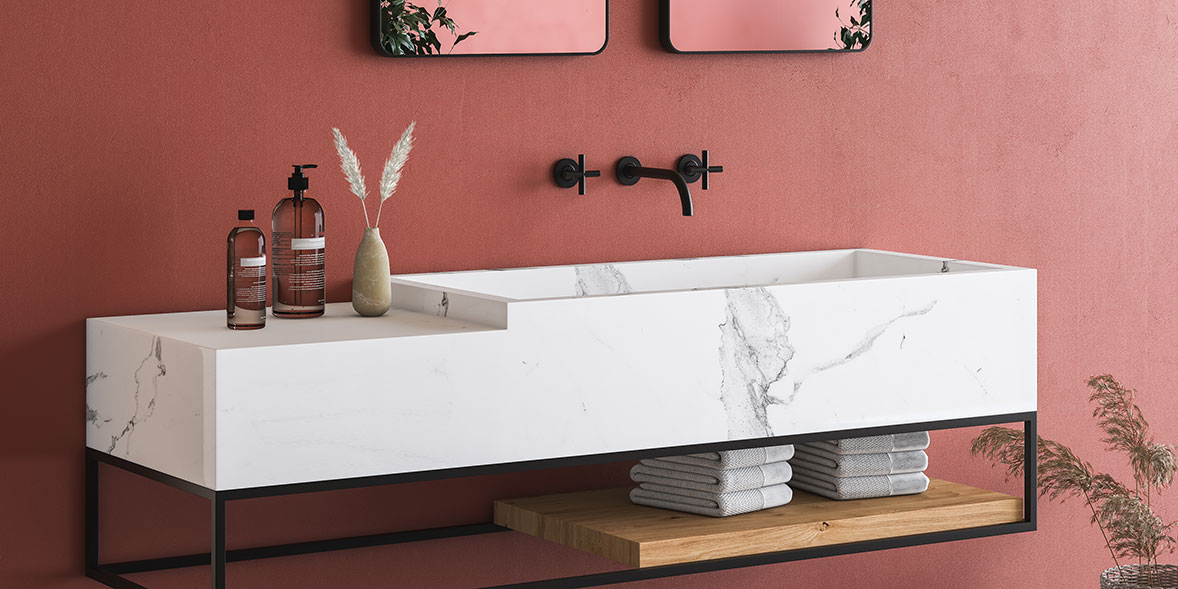
Bathroom paint ideas
Rather than painting a wall in the typical way, you could play with effects:
- stippling/textured using a sponge, rag, end of a brush or roughed-up roller, for a unique look each time
- ombre – where the colour goes from deep to light
- wood-effect – there are specialist tools that can create this look
- splashed – a fun but messy option
- mosaic/patchwork – using blocks of different colours
- patterned – using masking tape to make all manner of designs
- stenciling – there are a huge range of options available, or you could create your own.
Bathroom tile paint
Just like your bathroom walls, tiles can also receive a makeover with a pot of paint.
There are a few types of tile paint designed specifically for different areas, such as floors and showers, and different materials (including metal, glass and stone) so firstly choose the right type. Like bathroom paints, they should be water-resistant, tough and washable.
However, your colour choice can sometimes be limited, so you could consider using a high-quality, solvent-based primer and then washable latex, oil high-/semi-gloss paint, although these might not be as durable as a dedicated tile paint.
You may need to prepare the area before painting, removing any fungus, washing them with sugar soap and even possibly lightly sanding them. Most tile paints don't require primer first, but check the paint manufacturer's instructions.
Tile paint is the perfect solution if you're updating a bathroom, as a way to freshen up the look. But if you're installing a new bathroom and don't want to spend big, you could consider buying cheap, white tiles and giving them a lick of paint to bring them to life, particularly if you'd like patterned or bold tiles.
However, tile paint can sometimes be expensive, and most likely won't be as durable as a the tile itself, so is best done in areas where there won't be as much wear and tear or moisture.
For advice on how to find a good bathroom fitter, read our guide to bathroom installation
Bathroom ceiling paint
Because heat rises, your bathroom ceiling is the greatest hotspot for mould in your bathroom, particularly if it is on the top floor and the ceiling isn't well-insulated.
The same rules apply as with bathroom wall paint, but we'd highly recommend opting for an anti-mould paint with fungicide in it as opposed to trying one of the other types of paint, such as satin or gloss.
Lastly, remember that, like all other areas of the bathroom, there's no reason why you can't get creative too and see your ceiling as another canvas to paint.
Most mould-resistant paints are brilliant white, but you can find off-whites or even shades of grey. You could also consider using a high-gloss coloured paint on top of a specialist one, although it would be best to go for a dark colour to more easily hide any mildew growth that appears.
Bathroom design inspiration
Be bold with your design
Don't shy away from bold colours and designs. Gold and black are a perfect combination for a glamorous and eye-popping look. For maximum impact, how about a coloured bath or suite?
Use colour to create an atmosphere
Colour can evoke a desired feeling in your bathroom – blue tones, for example, can create a sense of calm. Use coloured tiles, paint or accessories to accentuate a feature or create zones.
Add wood for warmth and texture

Different woods can add texture and pattern to a minimal bathroom, creating the feeling of warmth. Consider using wood on a variety of surfaces, from countertops to flooring, or even walls. Just make sure it's treated and suitable for a bathroom.
Play with shapes and patterns
Combine patterns and shapes to create a striking look. Using one similar shape on a range of features will be particularly effective. A mirror in a different form will bring a focus to the idea and add another dimension.
Marry different textures and materials
A mixture of textures, materials and patterns can form an intriguing yet still cohesive look if you stick to a small palette of similar tones to avoid overloading the look. Freestanding furniture and open shelving will also create a clean and modern feel.
Make a statement with lighting
Don't forget lighting – hanging pendant lights will take a bathroom from standard to stunning. They can also be a good way to create a focal point.
Bring the outdoors in

Plants can be calming and add a luscious feel to your bathroom. Teamed with textured walls and wooden furniture, your bathroom will echo the rustic outdoors. Consider adding a statement too with a black bath.
Find out which brands offer you the best value for money according to their customers in our best and worst bathroom companies guide
Inclusive bathroom adaptations
Bathrooms adaptions can help make life easier for anyone who is elderly, disabled or has reduced mobility, who will be using the bathroom. There are many options available, including walk-in baths, bath lifts and hoists, and shower controls.
Tom Reynolds, CEO of the Bathroom Manufacturers Association, explained that inclusive bathroom products are a key consideration for both consumers and manufacturers: 'At some time in our lives, chances are we'll need a little support in the bathroom.
'Conventional taps and shower controls can be replaced with lever-operated controls for ease of use, along with remotely operated thermostatic control to decrease the risk of scalding. For those with a visual impairment, shower controls with touch buttons, tactile coding or illuminated controls are available.
'We encourage manufacturers to create bathroom products that are beautiful and functional, ensuring the bathroom meets the needs of all the family, regardless of age or ability.'
Other bathroom adaptations to consider are body driers, long-handled washing aids and wall mounted soap dispensers.
Be inspired to make home improvements. Sign up for our Home newsletter – it's free monthly






